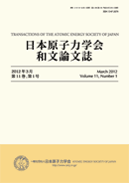
- Issue 4 Pages 101-
- Issue 3 Pages 64-
- Issue 2 Pages 50-
- Issue 1 Pages 1-
- |<
- <
- 1
- >
- >|
-
Minoru NAGAI, Toshiya KITAMURA, Eiji YOSHIMURA, Kenta HIBINO2024 Volume 23 Issue 4 Pages 101-117
Published: 2024
Released on J-STAGE: November 22, 2024
Advance online publication: November 12, 2024JOURNAL FREE ACCESS FULL-TEXT HTMLA 9 m drop test is required for type B nuclear fuel casks to simulate one of the transport accident conditions. Japanese regulation requires the evaluation of maximum damage and the condition inducing such damage in each cask following vertical, horizontal, corner, and inclined drop tests. For the inclined drop test, licensees are asked to clarify the effect of the secondary impact caused by falling in the case of a cask with high aspect ratio (length/diameter). However, in previous studies on a slap-down drop test for dual-purpose casks with a low aspect ratio (around 2.3) dropped at a small angle of inclination, it has been reported that acceleration due to the secondary impact acting on the main body significantly exceeds the primary impact acceleration. For this reason, we conducted a 9 m horizontal drop test and three slap-down drop tests (9 m −4 deg., 9 m −8 deg., and 9.4 m −8 deg.) using low-aspect-ratio (1.8) dual-purpose casks as 1/2.3-scale models to confirm the effects of slap-down drops on such casks. The drop height and slap-down angle were used as parameters for comparing the results of the horizontal drop test with those of the three slap-down drop tests. As a result, it was clarified that the maximum impact acceleration is higher in the slap-down drop tests than in the horizontal drop test even in the case of a low-aspect-ratio cask, and it increases to about 1.8 times the maximum in the case of the 9 m −8 deg. drop test condition. The significant effect of the slap-down drop was demonstrated, and therefore, the examination of the slap-down drop of the low-aspect-ratio cask is necessary in determining the condition that induces the maximum damage.
View full abstractDownload PDF (5550K) Full view HTML -
Kazuaki KOSAKO, Takuma NOTO, Hayato TAKESHITA2024 Volume 23 Issue 4 Pages 118-129
Published: 2024
Released on J-STAGE: November 22, 2024
Advance online publication: November 09, 2024JOURNAL FREE ACCESS FULL-TEXT HTMLReinforced concrete is generally used as a shielding wall for radiation facilities where γ- and X-rays are generated. The shielding effect should be varied by changing the diameter and pitch (spacing) of the reinforcing bars (rebars) in the reinforced concrete, as well as the radiation energy. We simulated the leakage radiation dose from the concrete with and without rebars. The radiation was consisted of γ- and X-rays emitted from a plane source. The shielding effect was evaluated by the ratio (decrease ratio) of the leakage radiation dose of the reinforced concrete to the dose of the concrete without rebars. The decrease ratio decreased linearly as the diameter of the rebars increased and increased exponentially as the γ-ray energy increased.
View full abstractDownload PDF (2810K) Full view HTML -
Hirokazu KUMEKAWA, Hironobu UNESAKI2024 Volume 23 Issue 4 Pages 130-148
Published: 2024
Released on J-STAGE: November 22, 2024
Advance online publication: November 14, 2024JOURNAL FREE ACCESS FULL-TEXT HTMLSince 1993, the treaty banning the production of fissile material for nuclear weapons and other nuclear explosive devices (Fissile Material Cut-off Treaty: FMCT) has been expected to promote nuclear disarmament toward the ultimate peaceful use of nuclear energy. However, the discussion toward its materialization has been stagnated. To overcome this stagnation, untangling various opinions and ideas, resolving conflicts among them for unification, and presenting an integrated, streamlined and consistent scheme must be proposed. This paper presents logical solutions to overcome the stagnation by reframing some key concepts and thus helps to unify diverse ideas into an optimized set that can best serve for the ultimate purpose of this long-awaited treaty.
View full abstractDownload PDF (1062K) Full view HTML
- |<
- <
- 1
- >
- >|